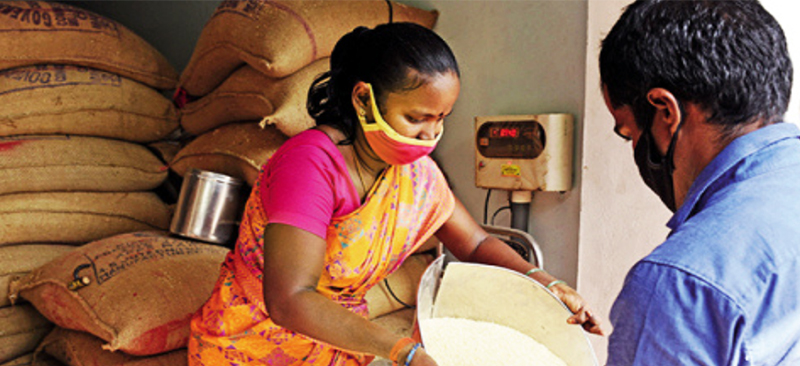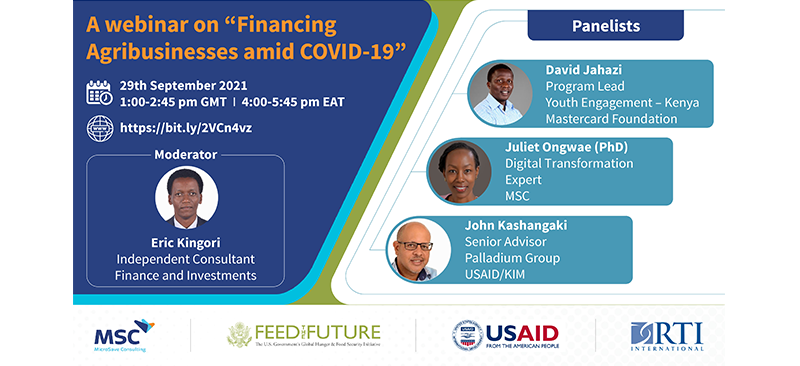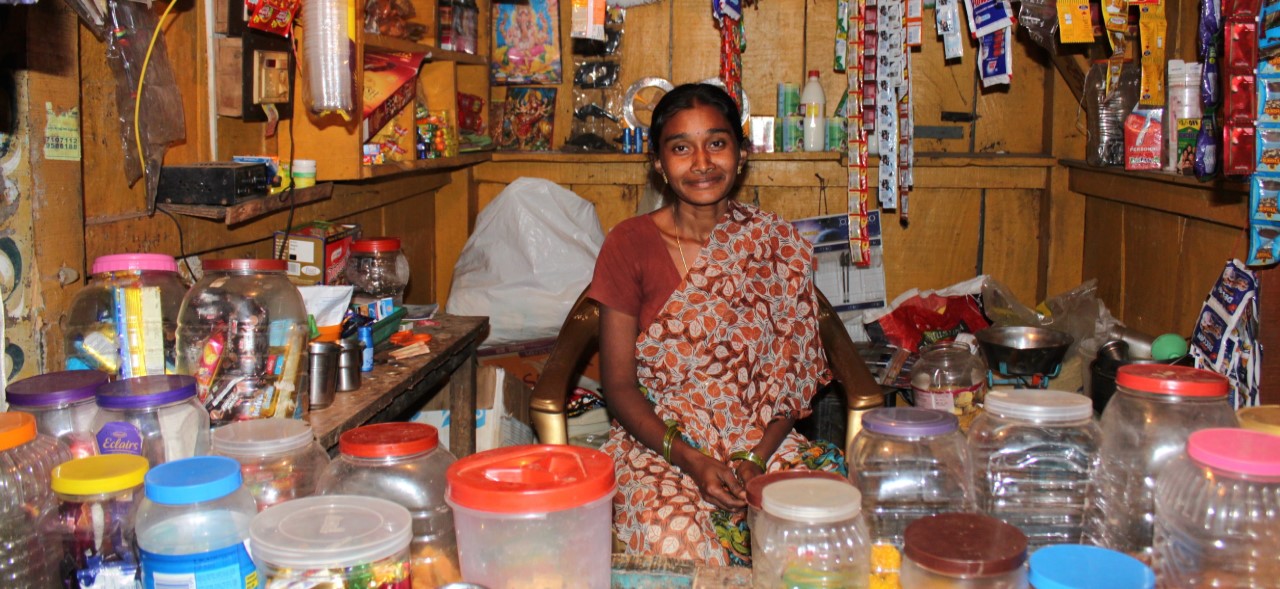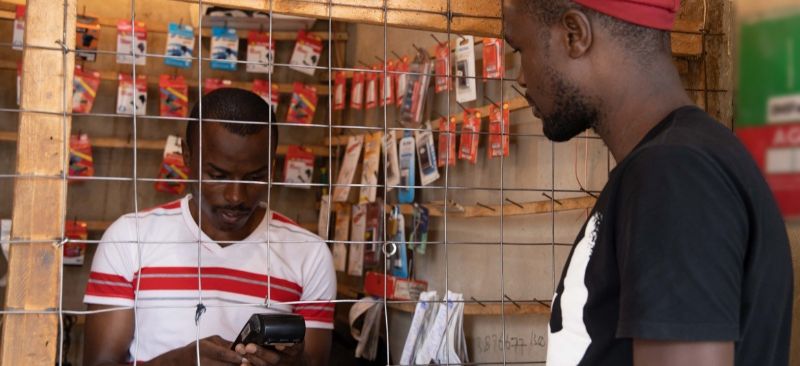The Government of India (GoI) ensures the food security of its population through the distribution of food grains to vulnerable sections at highly subsidized prices every month under the National Food Security Act (NFSA). In the wake of the COVID-19 pandemic, the government announced to distribute free food grains to around 800 million NFSA beneficiaries for eight months. The distribution of free food grains was a massive exercise carried out efficiently by the GoI. Timely delivery of benefits supported many households to survive through the testing times and safeguard their food and nutritional security
Blog
Efficacy of India’s food security response during COVID-19
The Government of India (GoI) ensures the food security of its population through the distribution of food grains to vulnerable sections at highly subsidized prices every month under the National Food Security Act (NFSA). In the wake of the COVID-19 pandemic, the government announced to distribute free food grains to around 800 million NFSA beneficiaries for eight months. The distribution of free food grains was a massive exercise carried out efficiently by the GoI. Timely delivery of benefits supported many households to survive through the testing times and safeguard their food and nutritional security.
A webinar on “Financing agribusinesses amid COVID-19”
A webinar on “Financing agribusinesses amid COVID-19”
The webinar featured conversations with representatives from both the demand and supply sides who revealed the situation on the ground. Participants explored the challenges that MSMEs in the agriculture sector grapple with as they seek finance during the pandemic. After this, a panel of experts brainstormed how governments, donors, and financial service providers can support these entrepreneurs to build back better.
The key themes for discussion were:
- Tuning into voices from the ground to gauge the impact of COVID-19 on MSMEs, women, and youth—to enable agriculture finance stakeholders to place theory into action;
- Innovation, coping mechanisms, and case studies of agriculture finance;
- Challenges that MSMEs in the agriculture sector grapple with as they seek finance during the pandemic;
- The role of key stakeholders, such as governments, donors, and financial service providers, in aiding a post-COVID recovery.
Click on the timestamps from the webinar stream to hear specific segments. You can also click on the image below to experience the complete webinar.
00:00– 2:20 Doreen Njau, Communications Manager, Anglophone Africa, opens up the conversation and introduces the topic for the day
2:28– 4:10 Kimotho Joseph, Access to Finance Specialist Feed the Future, Kenya Crops & Dairy Market Systems (KCDMS), gives the welcome note and sets the agenda for the webinar
4:39– 7:23 – Eric Kingori, Independent Consultant—Finance and Investments, gives the context of the discussion and introduces the participants
13:26– 15:42 Tom Kibet—Chief Operations Officer, Nuru Kenya responds to question 1: Paint a picture of how business was like before COVID-19 and how it compares to the situation today
16:01– 18:54 Daniel Musyoka—CEO and Managing Director, Biofarms Limited contributes to question 1. Paint for a picture of how business was like before COVID-19 and how it compares to the situation today
19:44–21:56 Vivian Opondoh—Tech entrepreneur responds to question 2: How did the disruptions caused by COVID-19 affect your access to finance?
22:34–23:49 Nehemia Odongo—CEO, Magos Farm Enterprises gives his perspective on question 2: How did the disruptions caused by COVID-19 affect your access to finance?
24:16 –29:41 Immaculate Ochieno—Lending Manager – East Africa, Shared Interest Society Ltd. gives her perspective from the supply-side on question 2: How did the disruptions caused by COVID-19 affect your access to finance?
30:21–33:31 Dr. Patrick Gathondu—CEO, BIMAS Kenya Microfinance Limited, also shares his perspective from the supply side on question 2: How did the disruptions caused by COVID-19 affect your access to finance?
34:11 –36:52 Dr. Patrick Gathondu responds to question 3: What do you foresee as the medium- and long-term changes? What changes are going to be irreversible?
37:16 – 39:50 Nehemia Odongo gives his perspective from the demand side on question 3: What do you foresee as the medium- and long-term changes? What changes are going to be irreversible?
39:57 – 52:55 – The panelists respond to a round of questions from the audience
Question 1) I wonder if lenders, such as funders, could be flexible with the terms of repayment of loans? In other words, did you have space to renegotiate the lending terms with your lenders?
Question 2) In the future, how do the financers ensure that agribusinesses are financed despite challenges around lack of guarantors or inappropriate guarantees?
Question 3) Are export-oriented crops the only ones that are financeable?
Question 4) What are the key variables one needs to consider from a business perspective given the impact of the pandemic?
1:00:10– 1:04:58 – Eric Kingori introduces the panel of three for a round of conversation
1:06:26– 1:08:59 John Kashangaki- Senior Advisor, Palladium Group- USAID/KIM responds to Question 1: What have been the sustained impacts of COVID-19 on the economy?
1:09:46 – 1:13:05 Juliet Ongwae (Ph.D.)—Digital Transformation Expert, MSC contributes to Question 1: What have been the sustained impacts of COVID-19 on the economy?
1:14:16 – 1:21:20 Jahazi David, Program Lead, Youth Engagement—Kenya responds from a gender and youth lens to Question 1: What have been the sustained impacts of COVID-19 on the economy?
1:21:50 – 1:26:54 John Kashangaki responds to Question 2: What interventions can development actors or governments undertake or are undertaking to address the adverse effects of COVID-19? How can these opportunities be exploited?
1:27:25 – 1:30:08 Juliet Ongwae gives her perspective on Question 2: What interventions can development actors or governments undertake or are undertaking to address the adverse effects of COVID-19? How can these opportunities be exploited?
1:31:30 – 1:35:10 Jahazi David responds to Question 3: What’s the approach that Mastercard Foundation currently uses to create dignified jobs in agribusiness amid the COVID-19 crisis?
1:39:19– 1:46:20 Dr. Robert Mwadime, USAID- KCDMS Chief of Party and Deputy Office Director- Office of Economic Growth and Integration, USAID present the concluding remarks.
Time to digitize ‘social welfare benefits’ and make them better accessible
India is a country on the move, with crores of people moving out of their villages and towns every year searching for better livelihood opportunities elsewhere in the country. Against this backdrop, social welfare benefits meant for them and other eligible beneficiaries must be made portable, so they can be availed no matter where the beneficiary is physically located at a given point in time.
A big step in this direction is the implementation of the One Nation One Ration Card (ONORC) under the Public Distribution System (PDS). Earlier, beneficiaries could get ration only from a specific fair price shop in their home locality. This limitation meant that migrants were denied their food grain entitlement at the destination. In one stroke, ONORC has solved this fundamental constraint. The reform’s grand vision is to allow beneficiaries to get their entitlement of government-subsidized wheat and rice from any fair price shop anywhere in the country, at their convenience. The implementation of ONORC has assumed greater velocity in the wake of the plight of domestic migrant workers since the Covid-19 pandemic began last year.
One of the key design features of ONORC is the concept of Single Source of Data (SSOD). SSOD is a data storage principle, whereby all the data is collected close to its source and stored in a centralized place to be accessed by all authorized parties, no matter where they are physically located. In any large system (like a government or corporate), if the SSOD principles are followed, it ensures that the data is verifiable and non-repudiable.
For ONORC, the Union government has collated the data about ration card-holders to a single, centralized platform that was held only at the state level until recently. The merging of the databases has made it possible for a migrant worker, say from Bihar to avail of food benefits even when he is in Maharashtra, where he may be working for a few months.
By using the SSOD concept in ONORC, India has created a good data management and governance model while providing the portability of services across geographical barriers. Similarly, the policymakers can consider adopting SSOD principles in their data management and implementing other social welfare programmes, to make them more efficient and provide nationwide portability.
How Single Source Enabled Ration Card Portability
Two-thirds of India’s population, or around 80 crore people, are entitled to subsidized food grain under the National Food Security Act (NFSA, 2013). The targeted beneficiaries under NFSA receive the foodgrain through the public distribution system (PDS).
In the last decade, the governments, both at the state and the union level have taken rapid strides in reforming the PDS. At the union government level, one of the most important reforms was the end-to-end computerization of PDS operations. This included digitization of the beneficiary database, online allocation of food grain, and computerization of the supply chain (from FCI warehouses to FPS shops).
At the state-level too, the reforms included digitizing all the ration cards and seeding the Aadhaar number for each ration card. With these measures alone, the states and union territories could remove around 4.39 crore fake, ineligible, duplicate ration cards between 2013 to 2020. Further, to make ONORC possible, states have shared their ration card databases with the union government, creating a central-level database. By now, 34 states have implemented ONORC, while two more states — Chhattisgarh and Assam — are likely to get on board within a few months.
Those entitled to get subsidized food grains are already availing the benefits of ONORC. Presently, a monthly average of about 2.2 crore portability transactions (including inter-/intra-State and PM-GKAY foodgrain transactions) are being recorded in ONORC.
There are four main ways in which ONORC incorporates the SSOD principles:
Data collection close to the source of data: States collect information about ration card-holders, such as their names, age etc., at the unit closest to them, such as at village level. In addition, beneficiaries’ credentials are validated using biometrics and Aadhar card details, reducing the possibility of fake beneficiaries making the data reliable and non-repudiable data.
Creation of a centralized database: Though ration cardholder data is collected and managed by states, it is also shared with a centralized database and updated periodically. By seeing all state-level data on a single, central dashboard, policymakers can get the big-picture of what’s going on across the country. This data can be used to support budget baselines, help data-based cost estimates of projects, remove duplicate beneficiaries and for setting performance benchmarks for departments.
Real-time data sharing: The ONORC platform has been set up such that when a beneficiary makes a transaction, both the state and central-level databases are updated in real or near real-time. For instance, when a person from Bihar withdraws food grains from Delhi, the system sends a message to the centralized database, Bihar, and Delhi databases, that a transaction has happened. This reduces the chance of ‘double-dipping’ where a person can withdraw grains from two places simultaneously.
‘Minimalism’ by design: While each state collects the beneficiary and the transaction details in their own way, the central database extracts only that information which is present across all the state databases using APIs. This allows states the freedom to continue collecting data that they feel is necessary.
The Backbone for Other Welfare Plans
ONORC isn’t the only programme that has implemented SSOD. Its principles were used to execute India’s LPG subsidy reform. In this, customer data that was being held across databases of three different oil marketing companies was collated in one place. This single database of beneficiaries allowed authorities to identify and weed out 4.49 crore duplicate, fake and non-existent beneficiaries. That saved the exchequer INR 71,301 crore, as on March 31, 2020.
Multiple other government welfare programmes can implement these principles to make them more efficient and effective.
The Single Source of Data principle can support various health initiatives for maternal and child health. Studies have shown that women who work as migrant labour have poorer health outcomes. These women often return home and by the time they get registered for health services, their pregnancy is in the last stages, compromising crucial health care for themselves and their unborn child. Solutions that include the portability of these services can be a huge step in ensuring better health outcomes.
Government’s much ambitious Pradhan Mantri Jan Arogya Yojana (PM-JAY), popularly known as Ayushman Bharat that aims to provide health insurance to 500 million people can be made portable through the SSOD principle to ensure that migrant people continue to get health cover as they move.
One prime use case would be in the world’s largest public-works programme provided under the Mahatma Gandhi Rural Employment Guarantee Act. In this, the government guarantees at least 100 days of employment to every rural household. Households can avail of this programme within a radius of five kilometers of their village, and in some cases, it is available at the block level. However, if the programme could be made portable, it would allow villagers to find employment anywhere in India.
This blog first appeared as an Op-ed in the ET Government on September 30, 2021.
Click here to go back to the building state capacity website.
Facilitating cottage, micro, small, and medium enterprises during the pandemic
Cottage, micro, small and medium enterprises (CMSMEs) in Bangladesh are having an increasingly challenging time under the COVID-19 pandemic. 94 per cent of enterprises experienced a significant loss of sales in 2020, with a 49 per cent decrease in sales on average for micro-enterprises. This is likely to decline further in 2021. The struggle for survival is not new for CMSMEs. These enterprises operate on slim margins (IFC, 2020), have a high dependence on the supply chain, and face cash-flow issues. The pandemic has aggravated these problems.
Furthermore, they face low customer demand, business closure due to state lockdown policies, and reduced opportunities to meet new clients. CMSMEs account for about 99 per cent of all business units in Bangladesh. Studies mention that 99 per cent of about 7.7 million CMSMEs in the country are in distress, failing to pay wages to workers and struggling with the impact of the economic slowdown caused by the COVID-19 outbreak.
Stimulus packages and disbursements: The government announced stimulus packages in different categories for industries to recover from the economic crisis caused by the pandemic outbreak. These include a package of USD 3.55 billion for large-scale industries and services sector, a package of USD 2.37 billion and an additional package of USD 35.5 million for CMSMEs, a package of USD 1.51 billion for export-oriented industries, a package of USD 591 million for farmers and a package of USD 355 million for people of low-income groups. Due to the slow disbursement of working capital loans for the CMSME sector initially, the government introduced a credit guarantee scheme of USD 236 million to encourage banks to extend loans to CMSMEs.
However, financial service providers disbursed only 60 per cent of the CMSME package until January 2021 and 75 per cent until May 2021. The finance ministry noted that only 10.8 per cent of this went to low-income farmers, and cottage and micro enterprises. Bangladesh Bank data indicate that of the USD 1.78 billion earmarked for the CMSMEs, the largest share has gone to small and medium enterprises engaged in manufacturing and service, with very few cottage and small enterprises in manufacturing or trading receiving these loans.
The wellbeing of CMSMEs is vital for socio-economic development both at the national and enterprise level. CMSMEs together account for 80 per cent of industrial employment. Their contribution to the GDP is said to be 25 per cent , and their export contribution is said to be 75 per cent. CMSMEs impact Bangladesh’s national strategic plans such as Vision 2021 (based on the Perspective Plan 2010-2021) and Vision 2041 (the Perspective Plan of Bangladesh 2021-2041, which seeks to eliminate extreme poverty, reach the upper-middle-income country status by 2030). COVID-19’s impact on CMSME might also adversely affect the country’s graduation from the least developed country to the status of a developing country. This is scheduled to happen in 2026 according to the government.
Stakeholders need to take a more strategic view of CMSMEs: Lenders’ inability to serve all CMSMEs is a symptom, not the root problem per se. Many CMSMEs cannot meet bank requirements and are unwilling to apply for the package because of the lengthy process. A survey by the Dhaka Chamber of Commerce and Industry (DCCI) earlier found that 59 per cent of the CMSMEs found the disbursement process complex, and 18 per cent of them were still unbanked, while many said that the loan amount is insufficient.
This is not all. The trade licensing and licence renewal is a lengthy process that CMSMEs do not want to go through as the opportunity costs are high. Formalisation of CMSMEs has perils too – many CMSMEs still do not want to be account for value added tax (VAT). Is there a way that will promote the formalisation of CMSMEs? Some initial thoughts could include a more straightforward registration and renewal process, with increased ceilings to counter the additional burden of taxes.
Formalisation alone will not help CMSMEs: Bangladesh must develop strategies to promote and enhance entrepreneurship at the grassroots. These may include incentives for digital adoption where agent banking and mobile money providers offer cash incentives for business transactions of CMSMEs. Digital literacy and awareness campaigns are designed for CMSMEs through the network of Union Digital Centers (UDCs). The role of Microfinance institutions (MFIs) to support CMSME entrepreneurs needs to be formalised. MFIs can emerge as a viable alternative to fund MSMEs due to their vast network across Bangladesh and experience in handling high-volume, low-value portfolios. MFIs in the country serve 32.34 million CMSMEs already. If the government channelled the relief funds directly via MFIs – many more CMSMEs would have received support during these times of distress.
Similarly, data disaggregated by gender and geography — for example, any data that allows comparison between women and men CMSMEs, or comparison between CMSMEs in Sylhet and Rajshahi — could inform and enhance policy-making to support CMSMEs.
Categorisation of CMSMEs: The most important and strategic step, however, will be to refine the categorisation of CMSMEs for improved targeting. The current bundling of CMSMEs includes medium enterprises, which often take the form of large factories. A smaller, well-defined group of the cottage, micro, and small enterprises can help the government provide better-targeted support. For example, New Zealand has a specific Small Business Strategy catered toward enterprises with 20 or fewer employees.
The definition of small enterprise in Bangladesh is not drastically different from that of New Zealand. Still, the fundamental contrast is that there isn’t a policy specifically for small businesses. Also acknowledged by the Industries Minister of Bangladesh, the definition of medium enterprises needs to evolve for the betterment of CMSMEs and 7.8 million Bangladeshis who are directly and indirectly linked to CMSMEs.
The Financial Express first published this article on 25th September, 2021.
Making Elephants Dance – A case study on shared agent banking in Uganda
FSD Uganda commissioned MSC to conduct a study and document how shared agent banking came into play in Uganda, why it was necessary, what has gone well so far, the challenges encountered, and the lessons learned. As the title of this case study suggests, uniting the vision and direction of at least 19 supervised financial institutions and getting them to collaborate in a typically competitive space is a difficult task, akin to Making Elephants Dance.
This case study covers:
- The circumstances that led to the introduction and development of the shared agent banking network;
- The functionalities and implementation of the shared agent banking platform and how these may have contributed to the operational success of the system;
- The key successes, weaknesses, challenges faced, and opportunities for the shared agent banking network in Uganda; and
- Key lessons from the implementation of the shared agent banking network in Uganda and exploring how these may be replicated in other markets that seek to implement a shared agent network.
We welcome you to read this report here:





